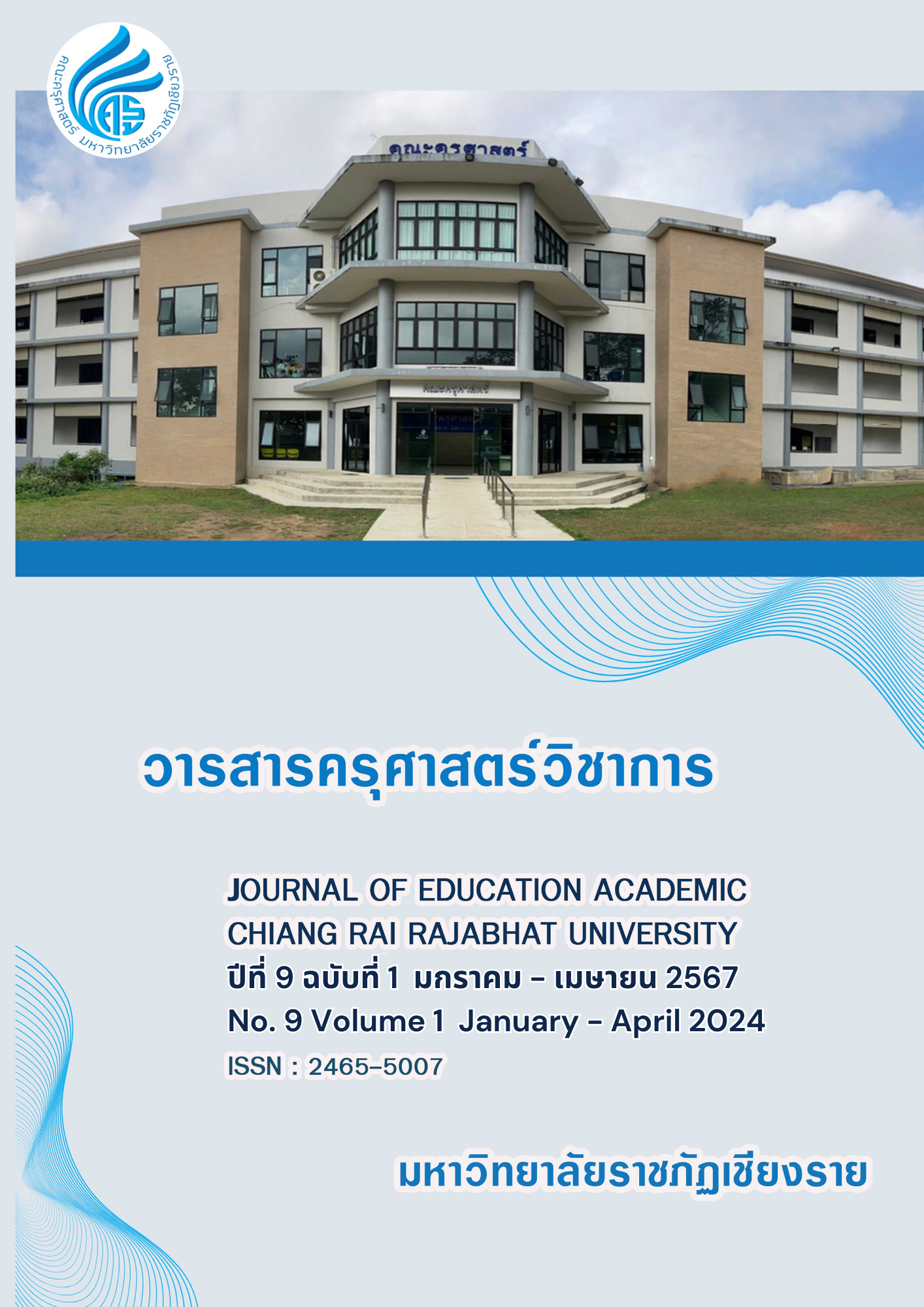Development of Learning Achievement in Mathematics on the Topic of Equality in all Respects using Van Hiele Theory for Grade-8 Students
Keywords:
Mathematics Learning Achievement, Exact Equality, Van Helie Theory, Grade-8 StudentsAbstract
The objectives of this research are (1) to develop mathematics learning achievement; Regarding equality in all respects using Van Helie's theory for Grade-8 students to have efficiency according to the 80/80 criterion. (2) To compare academic achievement in mathematics. Regarding equality in all respects using Van Helie's theory for Grade-8 students between after school and before school. (3) To study satisfaction with learning achievement in mathematics. About equality in all respects using Van Helie's theory for Grade-8 students. The sample group was students at Wachiratham Sathit School. Bangkok, 30 students, obtained from stratified random sampling. Research tools include learning activity plans. Mathematics Achievement Test and satisfaction measurement. Research tools include learning activity plans. Mathematics Achievement Test and satisfaction measurement Statistics used to analyze the data include the arithmetic mean (M), standard deviation (SD) and A dependent t-test.
The results of the research found that (1) the efficiency of the learning activity plan the efficiency is equal to 85.98/84.06, according to the specified criteria. (2) Comparison of academic achievement in mathematics. The period after studying was significantly higher than before studying at the .05 level. (3) The level of satisfaction with the development of overall learning activities was at a high level with an average of 4.89.
References
กมลทิพย์ สมบัติธีระ และคณะ. (2556). การพัฒนาการเรียนรู้คณิตศาสตร์ตามรูปแบบของ van Hiele โดยใช้โปรแกรม The Geometer’s Sketchpad ช่วยในการเรียนรู้เรื่องรูปเรขาคณิตสามมิติและปริมาตรของทรงสี่เหลี่ยมมุมฉาก ชั้นประถมศึกษา
ปีที่ 6. (วิทยานิพนธ์ศึกษาศาสตรมหาบัณฑิต สาขาวิชาหลักสูตรและวิธีการสอน). บัณฑิตวิทยาลัย: มหาวิทยาลัยขอนแก่น.
กระทรวงศึกษาธิการ. (2561). หลักสูตรแกนกลางการศึกษาขั้นพื้นฐาน พุทธศักราช 2551 (ฉบับปรับปรุง พุทธศักราช 2560). สืบค้นเมื่อ 10 ธันวาคม 2566. เข้าถึงได้จาก http://opec.go.th/ckfinder/userfiles/files/general/ 123(2).pdf
ชัยยงค์ พรหมวงศ์. (2556). การทดสอบประสิทธิภาพสื่อหรือชุดการสอน.วารสารศิลปากรศึกษาศาสตร์. 5(1), 7-20.
ยุพิน พิพิธกุล. (2546). เทคโนโลยีสื่อการสอนคณิตศาสตร์.กรุงเทพมานคร: สำนักส่งเสริมฝึกอบรม.
สถาบันส่งเสริมการสอนวิทยาศาสตร์และเทคโนโลยี. (2561). หนังสือเรียนรายวิชาพื้นฐานคณิตศาสตร์ชั้นมัธยมศึกษาปีที่ 1 เล่ม 1 กลุ่มสาระการเรียนรู้คณิตศาสตร์ (ฉบับปรับปรุง พ.ศ. 2560) ตามหลักสูตรแกนกลางการศึกษาขั้นพื้นฐาน พุทธศักราช 2551. โรงพิมพ์ สกสค. ลาดพร้าว.
สถาบันส่งเสริมการสอนวิทยาศาสตร์และเทคโนโลยี. (2562). การจัดสาระการเรียนรู้กลุ่มคณิตศาสตร์หลักสูตรการศึกษาขั้นพื้นฐาน. กรุงเทพมหานคร: สถาบันส่งเสริมการสอนวิทยาศาสตร์
สิริพร ทิพย์คง. (2545). หลักสูตรและการสอนคณิตศาสตร์. พัฒนาคุณภาพวิชาการ(พว).
อลงกรณ์ ตั้งสงวนธรรม. (2561). การใช้รูปแบบ Van Hiele ในการพัฒนาการเรียนการสอนการพิสูจน์ทางเรขาคณิต สำหรับนักเรียนชั้นมัธยมศึกษาปีที่ 3. วิทยาสารเกษตรศาสตร์ สาขาสังคมศาสตร์. 39(1), 634-644.
อัมพร ม้าคะนอง. (2554). ทักษะและกระบวนการทางคณิตศาสตร์: การพัฒนาการเพื่อพัฒนา. กรุงเทพมหานคร: โรงพิมพ์แห่งจุฬาลงกรณ์มหาวิทยาลัย.
อนุพงศ์ สุขเกษม. (2566). ผลการประยุกต์ใช้แนวคิดการจัดการเรียนรูปของ Van Hiele ร่วมกับการจัดการเรียนรู้แบบจิ๊กซอว์ ในการจัดการเรียนรู้คณิตศาสตร์ เพื่อพัฒนาระดับการคิดเชิงเรขาคณิต ผลสัมฤทธิ์ทางการเรียนเรื่อง พื้นที่ผิวและปริมาตรและความสุขในการเรียนรู้ สำหรับนักเรียนชั้นมัธยมศึกษาปีที่ 3.วารสารครุศาสตร์ มหาวิทยาลัยนครพนม. 4(3), 1-14.
Bruner, J. S. (1993). Explaining and Interpreting: Two ways of using mind. In G. Harman (Ed.), Conceptions of the human mind: Essays in honor of George A. Miller. Hillsdale, NJ: Lawrence Erlbaum Associates
Mary, M. E. (1990). Application of van Hiele model in elementary teacher understandiog of geometric concepts and improving their attitudes toward teaching geometry. South Florida Dissertation of University of South Fiorida.
Maslow, A. (1970). Motivation and personality. New York: Harper and Row.
Skinner, BF. (1953). Science and Human Behavior. New York: The Free Press.
Van de Walle, J.A. (2004). Elementary school mathematics: Teaching developmentally. Fourth edition. New York: Longman.
Van Hiele, P.M. (1986). Structure and insight: A theory of mathematics education. Orlando, FL: Academic Press.
Van Hiele, P.M. (1999). Developing geometric thinking through activities that begin with play. Teaching Children Mathematics. 50(3), 310-316.
Wilson, J. W. (1971). Evaluation of Learning in Secondary School Mathematics. In Handbookon Formative and Summative veluation of Student Learning. Edited by Benjamin S.Bioom. U.S.A.: Mc. Graw-Hill.
Downloads
Published
Issue
Section
License
Copyright (c) 2024 Journal of Education Academic Chiang Rai Rajabhat University

This work is licensed under a Creative Commons Attribution-NonCommercial-NoDerivatives 4.0 International License.






